Presented by Garmin
If ice fishing is viewed as a slow sport, it is only by those who have never fished a tip-up.
Though they may seem simple on their surface, few things in the fishing world match the excitement of a tripped tip-up flag, bringing grown men and women to their feet as fast as just about any pastime in the country.
Thankfully, what tip-ups offer in excitement, they match in effectiveness and these tools can become essential to putting fish on the ice, especially when things get slow.
So in honour of that “slower” part of the ice fishing season being upon us once more, here is our complete guide to all things tip-up fishing.
What is a Tip-Up
Before we get into how and when to use them, a definition is first in order.
While the definition has slowly been changing as the technology has advanced (more on this soon), tip-ups still remain, at their core: tools to suspend bait in the water column at a set depth without needing to be actively manned by an angler.
In all styles of tip-ups, this is achieved using a spool, a line, and some form of strike indicator. How these devices achieve this goal, however, is becoming much more variable.
Types of Tip-Ups for Ice Fishing
Though it is impossible to include all varieties of tip-ups, here are a few of the ones you are most likely to run into out on the ice.
Traditional:
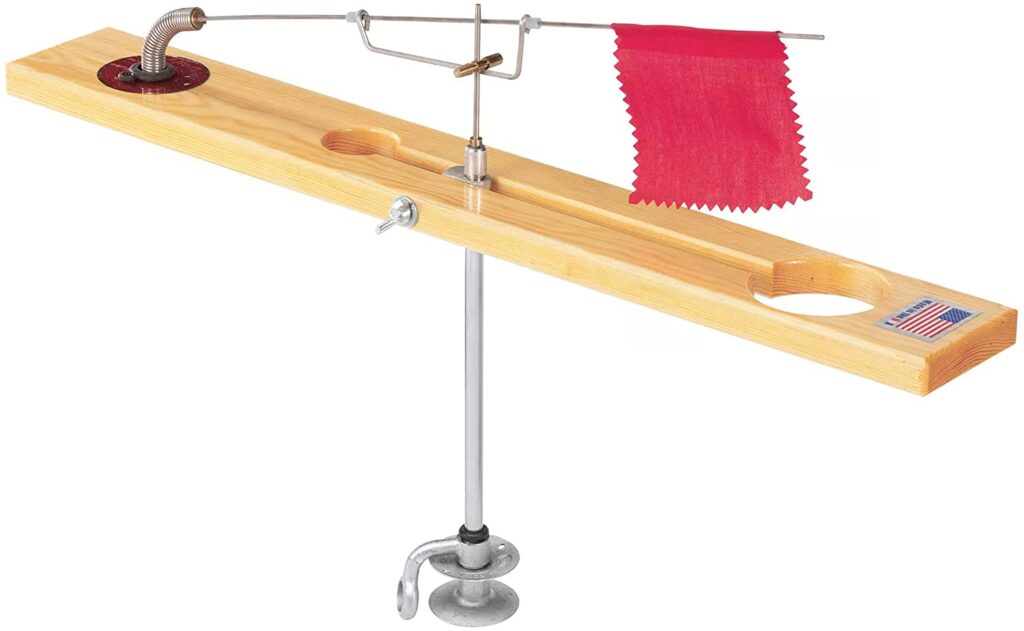
If you have been ice fishing for a long time, this is likely the tip-up you are used to seeing.
Also called a “rail tip-up”, these time-tested tools work by providing anglers with a spool to hold their line, a wooden rail to keep the base of the device above the hole, and a small trigger attached to a flag to let anglers know when their line has begun to move.
The pros of this classic system is that they are absolutely fool-proof and can catch fish while requiring just minutes of setup time.
The con, however, is that the rail system leaves much of the hole open to the elements, making frozen holes a common occurrence on especially cold days and lost fish a possibility when this occurs. For this reason, some northern ice anglers have opted for a more recent rendition of this classic system.
Thermal:
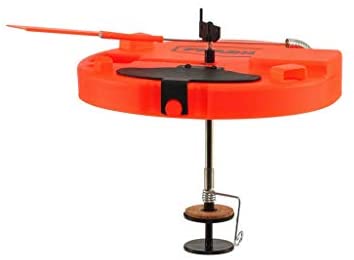
The con mentioned for the traditional-style tip-up was centred around frozen holes and this variation was designed to solve it.
Consisting of essentially the same components as the traditional tip-up, the thermal models simply swap out the long wooden rail for a rounded piece of plastic. This rounded base, often filled with styrofoam, keeps air from reaching the water in your ice fishing hole and keeps ice from freezing it into place. Many of these models also have built-in tackle storage, making them slightly more convenient than some of the more basic models.
Hook Setters:
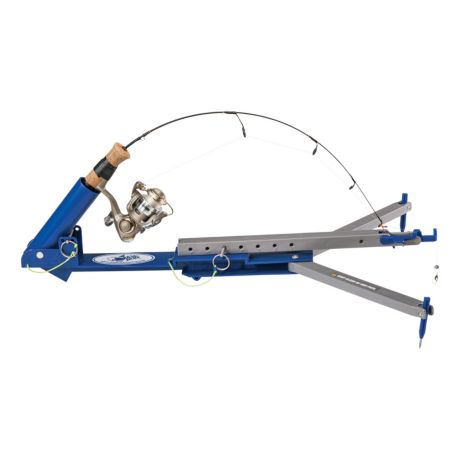
The final, and most recent variation on the ice fishing tip-up is the hook setter.
Differing almost entirely in design from the traditional tip-up, all these have in common with their now-distant cousins is their goal of suspending bait.
Instead of the spool being below the water, the hook setter tip-up allows you to use your own ice fishing rod and reel, coming equipped with rod holders and place to clip your line into the device. Since the rod tip and line are now clipped into the device, the tripping of the trigger now causes the rod, not a flag, to spring upward which sets the hook for the angler.
One tip when using these devices is to use a high-quality ice fishing rod as these devices do set the hook significantly harder than you might if you were sitting in a hut. We have personally seen old, low-quality rods explode when the Jaw Jacker is tripped and walking out of a hut to see the spool of your reel bouncing around on the ice is never a fun sight (trust us…).
Also, it is a good idea to attach a few bells to the rod as the lack of a flag can make it difficult to tell from afar if a fish is on the line or if it is still fastened in place. With bells, simply listen for the sound and start running.
BONUS: Primitive
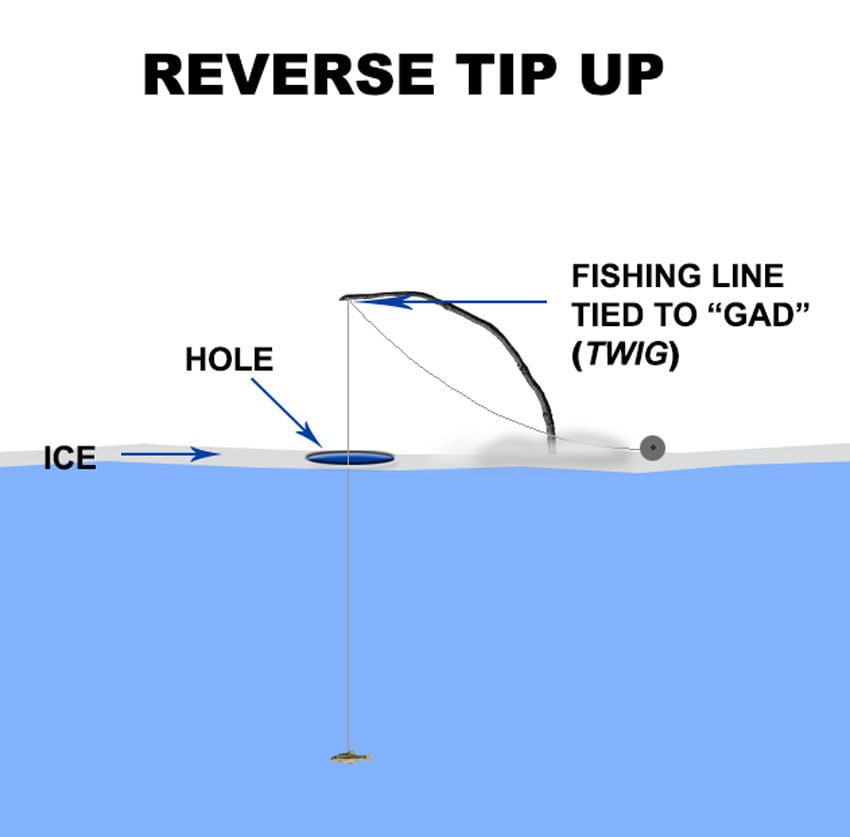
For those who forgot their tip-up at home or want to get back ice fishing’s roots, these devices can also be made at the lake. Here is Pete Bowman’s experience with the “primitive” tip-up.
“Way back in my Napanee days, one of our “poor man’s” tip-up was literally a tip-down. My buddy, Darby, called it a “Gad”. Where that name came from, I still have no idea.”
“What we’d do is take whatever line-holding unit we had, (spool of line or full-sized rod and reel or an ice fishing rod and reel) drop our bait to the desired depth, and then make a loose knot on the end of a soft twig that was stuck in the snow. All we would do then is keep watching that Gad to see if it was torquing towards the water… then it was game on!”
How to use a Tip-Up
Now that we have covered the type of tip-ups you are heading out to the lake with, it is time to figure out how to fish them. For the purposes of this article, we are going to focus primarily on traditional and thermal tip-up models.
Setup
Step 1: Drill Your Hole
An obvious first step but an important one nonetheless.
Step 2: Spool Your Line
This step can also be done at the house but is easy enough to do out on the ice. The types of line used on a tip-up will be discussed further below, but no matter what kind of line you use, your knot will be the same.
We like to use an arbour knot or a modified slip knot whenever we tie our line to a spool but, to be honest, any knot that tightens on itself will serve the purpose. Adding a strip of electrical tape underneath or on top of the knot will also help prevent slippage if you were to get spooled.
Step 3: Set Your Depth
Now that your line is on your spool, it is time to set your depth.
Unlike a reel, tip-ups do not have a bail to open, so release your line by simply pulling it through the single guide and out of the spool. This is much easier with a fishfinder as it allows the angler to watch the bait as it falls and stop it at the desired depth. If you do not have access to one, let it fall to bottom and then retrieve the amount you would like to sit above.
Step 4: Watch Your Flags and Reel Them In
Now for the fun part.
As mentioned in the intro, few things get grown men and women running faster than the raised orange flag of a tip-up, turning the tame hobby of ice fishing into something that might resemble an extreme sport.
To make sure your race begins on time, try positioning your hut with the windows facing your tip-up and keep an eye on them every few minutes. If you’re looking for a modern solution, Bluetooth tip-up alerts are also available.
Once you reach your tip-up, give the line a quick hookset and then begin retrieving the line, hand over hand. This way of retrieving is much more effective than the small reel on the tip-up and will keep the tip-up line in a neat pile if the fish decides to run.
Step 5: Watch your tip-up using Garmin LiveScope
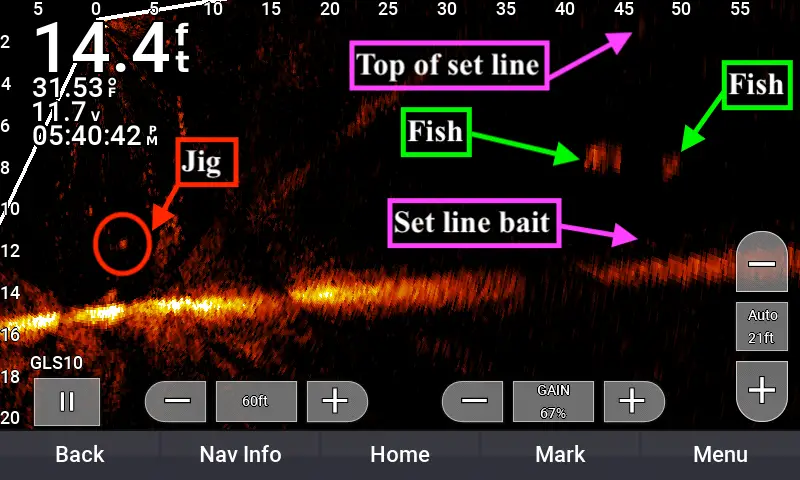
As mentioned above, tip-ups are tough to keep an eye on, especially when fishing from a hut. To get a leg up on your fishing buddies in this first-come-first-serve game, LiveScope, particularly Forward View, can be a gamechanger.
As you can see in the screenshot above, we were able to watch our tip-up from over 45 feet away while we jigged from the comfort of our hut. In this particular case, it also allowed us to see that the fish near our bait were suspended, rather than drawn to the bottom, and helped inform us that our bait should be moved higher in the column.
Line
Similar to open water fishing, line choice ultimately comes down to preference. However, we do have a few recommendations.
For starters, since tip-up spools tend to be small, we like to select the thinnest line we can without compromising strength. This is why we tend to prefer braid, particularly ice braid, as it provides the strength we are looking for in a diameter small enough to fit a large amount of line on our spool.
Since this line is visible, however, a leader becomes necessary. For this section of line, we like to use a fluorocarbon leader as it sinks much better than mono and stretches far less easily. If we are fishing for aggressive, toothy fish such as Northern Pike, this leader will be swapped out for wire.
Baits
When it comes to bait selection for tip-ups, nothing beats live bait.
“Matching the hatch” is always recommended when selecting bait for your area, meaning you should try to use the bait species that the fish you are targeting are eating in the wild. A quick Google search of the lake you are fishing can give you a good idea of what exists in the lake, but a quick call to a local tackle shop can offer the same result.
Whatever type of live minnow you choose, rigging can be done on both a bare hook and split shot or a jig head, as the action of a spoon or lure is not necessary since the bait will be stationary.
Dead bait can also be effective when live is not available, particularly the heads of frozen, salted, or recently killed minnows.
When to use a Tip-Up
Here are a few situations, and species, where the tip-up thrives.
Establishing a Pattern and Covering Water
As with any style of ice fishing, location is key. The location of your tip-up, however, will change depending on how you are fishing them. On one hand, if the tip-up is your main/only line, set it up in your primary location. If it acts as your secondary line, on the other hand, set up your jigging rod in your primary location and use the tip-up as more of an exploratory tool.
For example, if you are jigging for Lake Trout in 70 feet of water, set your tip-up in 50 feet and use it as a tool to tell you where the fish are located. This will help save you time drilling holes, especially if you don’t have a fishfinder.
Slowing it Down for Weary Fish
Matching the pace of the fish you are targeting is another great reason to use a tip-up.
As we have discussed in previous articles here at Fish’n Canada, fish tend to slow down as the winter wanes on and become far less aggressive in their pursuit of food. When this occurs, many species prefer a deadsticked approach, making the tip-up and its still, natural presentation the perfect tool.
Tip-Up Species #1: Northern Pike
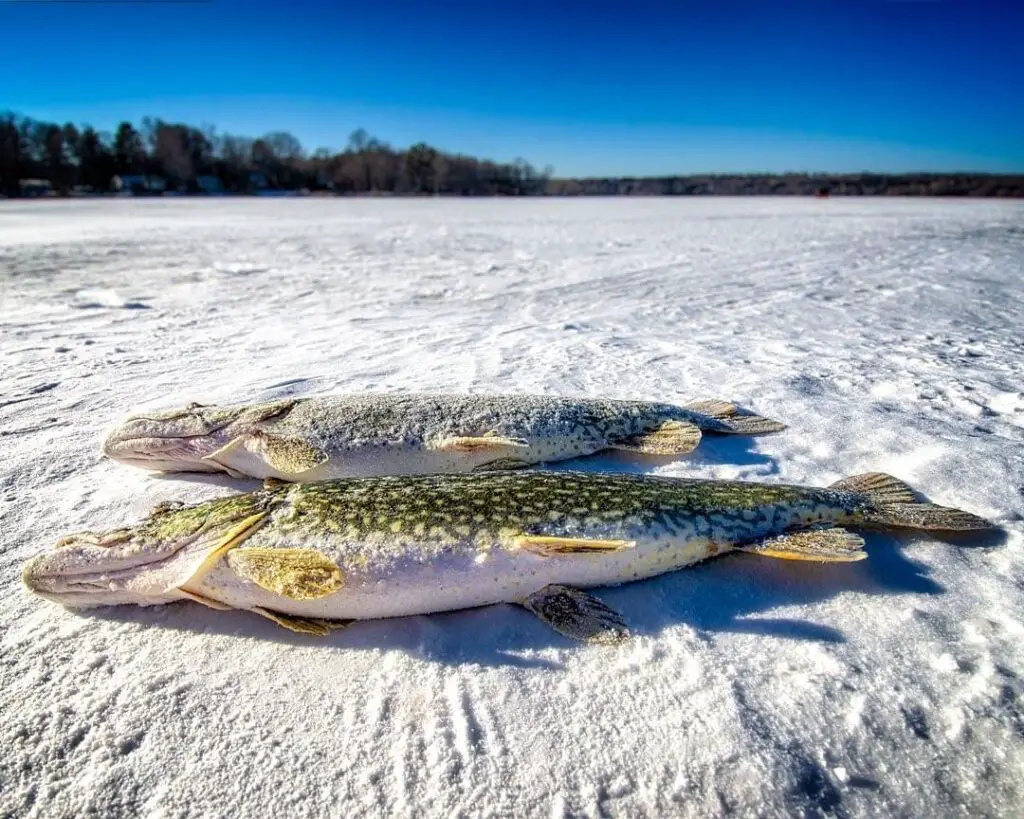
Northern Pike may be known for loving fast-moving baits, but this preference seems to be significantly toned down during the ice fishing season.
The slower style of tip-up fishing that they tend to prefer this time of year is often done in shallow water, anywhere between 5 and 10 feet. In these areas, anglers will often rig a large minnow (sucker minnows are the preference) with a single or treble hook through the back dorsal fin to allow it to swim naturally and wait for a big pike to cruise by. Quick strike rigs are also great tools for catching trophy pike through the ice.
As we mentioned earlier, the aggressiveness of Pike and their toothy mouths make wire leader or high pound test line a necessity.
Tip-Up Species #2: Rainbow Trout

Rainbows are another excellent species for tip-up fishing, especially when they slow down mid-season.
In fact, Chris Saunders, a northern Ontario/Quebec ice fishing guide, claims that tip-ups are the #1 tool for catching Rainbows under the ice.
“Oftentimes, Rainbows can be found cruising just inches below the ice,” says Chris. “To intercept these marauding fish, I like to set my tip-up along known migration roots, setting my bait just 6 inches to a foot under the ice.”
Chris also says that he does still jig with a traditional ice fishing rod as a way to pass the time, however, tip-ups are far more productive. Live minnows, worms, and trout nuggets are the baits of choice.
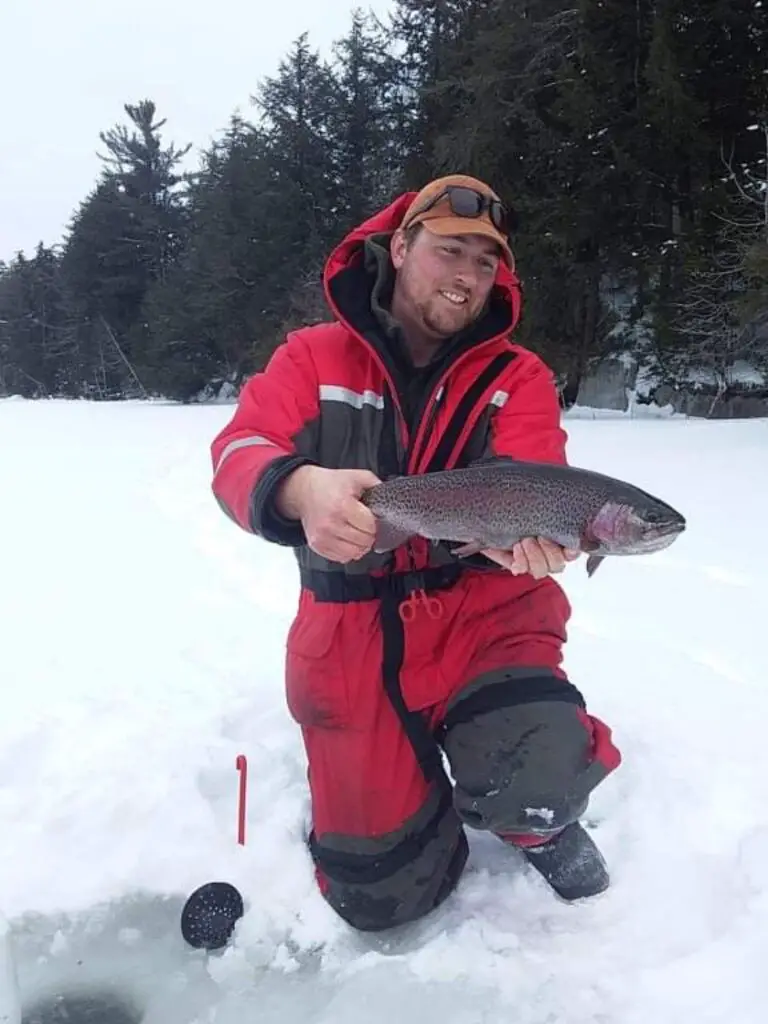
Conclusion
Tip-ups may seem simple on the surface but can become excellent tools for those who know how and when to use them and we hope this guide gave you plenty of reason to keep a few tip-ups in your sled this season.
